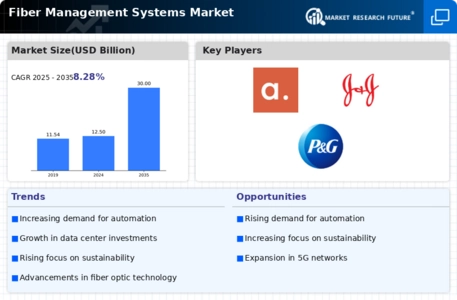Market Analysis
In-depth Analysis of Fiber Management Systems Market Industry Landscape
The Fiber Management Systems market exhibits a dynamic interplay of various factors that collectively shape its market dynamics. One key driver is the increasing demand for high-speed and reliable communication networks. As businesses and individuals rely more on data-intensive applications and services, the need for efficient fiber optic networks has grown substantially. This demand fuels the market's expansion as companies strive to deploy robust Fiber Management Systems to support the ever-increasing data traffic, leading to a continuous evolution in the market landscape.
Technological advancements play a pivotal role in driving the market dynamics of Fiber Management Systems. The industry experiences a constant influx of new technologies, ranging from improved fiber optic cables to advanced management and connectivity solutions. The race to stay ahead in this technological curve propels innovation, as companies seek to provide cutting-edge solutions that offer higher performance, scalability, and efficiency. Consequently, market players engage in a continuous cycle of research and development to meet the evolving needs of the telecommunications and data center sectors.
Government regulations and initiatives significantly influence the Fiber Management Systems market dynamics. Policies aimed at promoting the expansion of broadband infrastructure and the deployment of fiber optic networks can drive market growth. Incentives, subsidies, and regulatory frameworks that prioritize the development of high-speed communication networks contribute to the overall momentum of the market. Additionally, government-led initiatives to bridge the digital divide and improve connectivity in underserved areas contribute to the market's expansion.
Environmental considerations have become a crucial aspect of the Fiber Management Systems market dynamics. The growing awareness of the environmental impact of traditional cabling systems has led to an increased adoption of fiber optic solutions. Fiber optic networks are known for their energy efficiency, reduced carbon footprint, and overall environmental sustainability compared to traditional copper-based alternatives. As companies and industries prioritize eco-friendly practices, the demand for Fiber Management Systems as an environmentally conscious solution continues to rise.
The competitive landscape and the presence of key market players contribute significantly to market dynamics. The industry is marked by intense competition, with both established and emerging players vying for market share. Companies differentiate themselves through product offerings, technological innovation, and strategic partnerships. The constant pursuit of gaining a competitive edge leads to a dynamic market environment, where companies must adapt to changing trends and customer preferences to maintain or enhance their market positions.
Economic conditions also play a role in shaping the dynamics of the Fiber Management Systems market. Economic growth often translates into increased investments in infrastructure, including communication networks, which, in turn, drives the demand for Fiber Management Systems. Conversely, economic downturns may temporarily impact market growth as companies reevaluate their investments. The market's resilience and ability to adapt to economic fluctuations contribute to its overall dynamics.






Leave a Comment